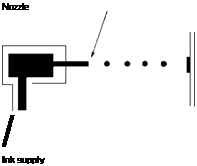Ink-jet printing is currently experiencing tremendous growth. It is a non-impact means of generating images which involves directing small
droplets of ink in rapid succession, under computer control, onto the substrate. There are a number of types of ink-jet printing methods. Two of the principal types are the continuous jet method and the impulse or ‘drop on demand’ method, although only the latter is considered here. In this method (Figure 10.11) pressure on the ink is applied to form a droplet when it is needed to form part of the image. An array of nozzles is used to generate the image and the print-head is required to be as close as possible to the substrate surface so as to produce an accurate image.
Ink-jet printing requires the use of inks which meet stringent physical, chemical and environmental criteria. Ink-jet printing inks are very low viscosity fluids as is required by the non-impact method of ink delivery. They have a remarkably simple composition consisting of a solvent, almost invariably water, and a colorant together with other additives for specific purposes. In contrast to most other printing inks, the colorants used are mainly dyes because pigments, even when an extremely fine particle size is used, have a tendency to block the nozzles. Initially, the dyes used in ink-jet printing were water-soluble dyes selected from the range of conventional dyes used in textile applications, notably from the acid, direct, or reactive dye application classes, or from food dyes, this last group offering the particular advantage of clearly-established non-toxicity. An example of such a ‘first generation’ ink-jet dye is C. I. Food Black 2. (238) (Figure 10.12). These early ink-jet dyes performed reasonably in many respects, but the principal problem was inadequate water-fastness which could, for example, lead to smudging of the print when handled with moist fingers. In the ‘second generation’ ink-jet dyes, this particular feature was improved, by the design of specific dyes which are soluble at the slightly alkaline pH (7.5-10) of the ink, but which are rendered insoluble by the weakly acidic pH conditions (pH 4.5-6.5) on the paper
 Paper
Paper
/
Figure 10.11 ‘Drop-on-demand’ ink-jet printing
|
Figure 10.12 Examples of water-soluble dyes used in ink-jet printing |
substrate. One of the simplest ways in which this was achieved involved the incorporation of carboxylic acid groups, which are ionised (as
CO2) at the higher pH, thus enhancing water solubility, but are protonated (as CO2H) as the pH is reduced, thus reducing solubility. An example of such a dye is compound 239 (Figure 10.12), whose molecular structure is closely related structurally to C. I. Food Black 2 (238) but with sulfonic acid groups replaced, to a certain extent, with carboxylic acid groups. Dyes of this type are capable of providing prints which are reasonably resistant to wet treatments. Ink-jet printing is currently used extensively for home and office printing, where high-quality text and graphics reproduction is required. The technology also offers considerable potential to make significant inroads in the future into higher volume industrial printing, for example for packaging, textiles, wallcoverings and advertising displays.
 13 января, 2016
13 января, 2016  Pokraskin
Pokraskin 
 Опубликовано в рубрике
Опубликовано в рубрике 